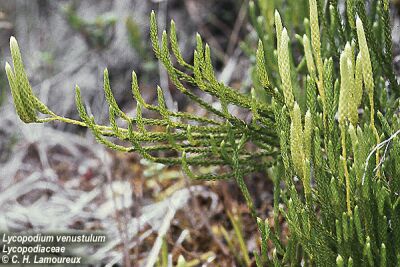
| Palaeos |  |
Lycopodiophyta |
| Plants | Lycopodiales |
| Page Back | Unit Back | Unit Home | Paleozoic Plants | Plants Glossary | Plant Kingdom |
| Selaginellales | Unit Next | Parent Dendrogram | Plants Links | Palaeontology | Timescale |
| Lycophyta Home | Drepanophycales | Protolepidodendrales | Lycopodiales | Selaginellales |
| Lepidodendrales | Miadesmiales | Pleuromeiales | Isoetales | Dendrogram |

The Lycopodiales are the most primitive living lycopsids and among the most ancient members of this group. They first appear for certain in the late Devonian (Famennian) with Lycopodites , although Huperzia. might extend as far back as the Middle Devonian (Eifelian), predating the first tetrapods. Recent forms (Lycopodium) are known as club-mosses. Unlike more advanced lycophytes, they are homosporous, producing only one kind of spore. The Lycopodiales evolved into the Protolepidodendrales during the Middle Devonian, initiating a great evolutionary radiation of lycophyte shrubs and trees.
This order includes the recent genus Lycopodium (known commonly as club moss, ground pine, or "wolf foot," ), with some 200 living species. Surviving species are mainly tropical, but several occur in Arctic and subalpine regions. Recent authorities suggest splitting Lycopodium into several genera. All are trailing plants from a rhizome. In some species, variations and gradations between dichotomous and monopodial growth patterns occur.
Order Lycopodiales
family Lycopodiaceae (Lycopodium, subgenera: Lycopodium Phylloglossum, Huperzia, Diphasium, Lycopodites)
Order Lycopodiales: images and brief descriptions of living species
Clubmosses: same, but with more detail